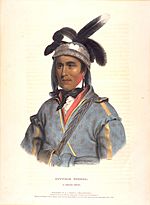Battle of Round Mountain facts for kids
Quick facts for kids Battle of Round Mountain |
|||||||||
|---|---|---|---|---|---|---|---|---|---|
| Part of the Trans-Mississippi Theater of the American Civil War |
|||||||||
 Battle of round mountain 2017 reenactment at disputed Battle site near Yale Oklahoma |
|||||||||
|
|||||||||
| Belligerents | |||||||||
| Loyal Indians | |||||||||
| Commanders and leaders | |||||||||
| Opothleyahola | Douglas H. Cooper | ||||||||
| Strength | |||||||||
| Unknown | 1,400 men | ||||||||
| Casualties and losses | |||||||||
| 110 casualties | 6 fatalities 4 wounded 1 missing |
||||||||
The Battle of Round Mountain was the first battle in the Trail of Blood on Ice campaign for the control of Indian Territory during the American Civil War that occurred on November 19, 1861. Its main purpose was to prevent Union supporters of the Creek Nation, led by Opothleyahola from fleeing Indian Territory to the protection of Union forces in Kansas.
The physical location of the battle is in dispute. Some historians believe it to be near Keystone while others contend that it is near Yale, Oklahoma. The event is sometimes referred to as the Battle of Red Fork.
Contents
Events
Col. Douglas H. Cooper, Confederate commander of the Indian Department, was unable to reconcile differences with Opothleyahola, commander of a band of Unionist Creeks and Seminoles. Opothleyahola" group was estimated to number about seventeen hundred people, and also included some Union supporters from the Comanches, Delawares, Kickapoos, Wichitas, and Shawnees. Cooper set out on November 15, 1861, with about 1,400 men either to compel Opothleyahola 's submission or "drive him and his party from the country." Cooper's force rode up the Deep Fork of the Canadian River to find Opothleyahola's camp deserted. On November 19, Cooper learned from captured prisoners that part of Opothleyahola's band was erecting a fort at the Red Fork of the Arkansas River.
Cooper's men arrived there around 4:00 p.m. Charging cavalry discovered that Opothleyahola's followers had recently abandoned their camp. The Confederates located and followed stragglers; the 4th Texas blundered into Opothleyahola's warriors on the tree line at the foot of the Round Mountains. The Federal response chased the Confederate cavalry back to Cooper's main force. Darkness prevented Cooper's counterattack until the main enemy force was within 60 yards (55 m). After a short fight, Opothleyahola's men set fire to the prairie grass and retreated.
The following morning, Cooper advanced on Opothleyahola's new camp but found that the Federal forces had fled. The Confederates claimed victory because Opothleyahola had left the area. The Confederates captured abandoned supplies, such as Opothleyahola's carriage, a dozen wagons, food, cattle and ponies. The Confederate loss in the engagement was 1 captain and 5 men killed, 3 severely and 1 slightly wounded, and 1 missing. Opothleyahola lost about 110 killed and wounded.
This was the first of three encounters between Opothleyahola's Union bands and Confederate troops. The Unionists were forced to flee to Kansas after the Battle of Chustenahlah at the end of the year.
Order of battle
Confederate
Cooper's Brigade - Col. Douglas H. Cooper
- 6 companies, 1st Regiment Choctaw-Chickasaw Mounted Rifles - Maj. Mitchell Laflore
- Detachment, 1st Creek Mounted Rifles - Col. Daniel N. McIntosh
- Detachment, 2nd Creek Mounted Rifles - Lt. Col. Chilly McIntosh
- Detachment, Seminole Indians - Maj. John Jumper
- Detachment, 9th Texas Cavalry - Lt. Col. William Quayle
Union
Creek and Seminole Indians - Opothleyahola
- Lockapoka Creeks
- Muscogee Creeks
- Seminoles - Halleck Tustenuggee, Sonuk Mikko


